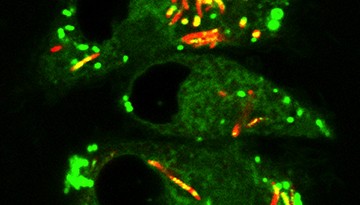Cornell University’s anti-TB compound goes under trial
A novel compound that has the potential to starve the bacteria that causes tuberculosis – the world’s leading infectious killer after SARS-CoV2 – is entering human clinical trials.
The clinical trials will be funded by the Bill & Melinda Gates Foundation, which in February announced a strategic licensing agreement with the biomedical research company Calibr to further develop the compound CLB073, which has shown promise against Mycobacterium tuberculosis (Mtb).
Under the agreement, Calibr has granted Gates MRI an exclusive license to continue work on CLB073, which was developed by CVM’s David Russell, the William Kaplan Professor of Infection Biology in the College of Veterinary Medicine (CVM), and Brian VanderVen, associate professor in the Department of Microbiology and Immunology (CVM).
Russell said he expects the human clinical trial, which will test CLB073 for safety, to begin in the next few months and last about a year.
CLB073 works by eliminating the bacteria’s carbon source. The compound activates the enzyme adenylyl cyclase (Rv1625c), which ultimately blocks Mtb’s ability to metabolize cholesterol – essentially starving it.
“We don’t yet fully understand the mechanism of action, but the bottom line is, it prevents the bacteria from eating cholesterol,” said VanderVen, who has been collaborating with Russell for the past 10 years.
The key to the discovery, Russell said, was attacking the bacterium where it lives, instead of the traditional model of putting the target bacterium in a solution of nutrient-rich broth for testing.
“Most drug discovery work is done in rich broth – and, in reality, the bacteria never sees rich broth,” he said. “So by putting the bacterium inside its host cell, you’re effectively constraining the bacteria’s ability to be flexible, which exposes additional drug targets. It was a theory that drove the drug screen, and it turned out to be correct.”
In preclinical mouse studies, CLB073 significantly enhanced the efficacy of Nix-TB drug regimen, the current standard of care for drug-resistant tuberculosis. In vivo testing has proven to be a game-changer, VanderVen said.
“We just asked a simple question: What kills the bacteria in the environment or the niche where it resides?” he said. “We screened the drugs in the context of the bacterium within its host cell, and that hasn’t been done on a large scale before.”
Russell said the mechanism behind CLB073 could be applicable to other diseases, as well.
“Brian has several other compounds that show much better activity in the host environment, and minimal to no activity in broth,” he said. “So I don’t think it’s unique to this particular compound or mechanism; I think it’s a conceptual approach that has tremendous value.”
Cornell and Weill Cornell Medicine are among the 25 members of the Tuberculosis Drug Accelerator, a network of academic, pharmaceutical, governmental and other organizations that work collaboratively to gain a better understanding of the disease and design high-impact drug candidates. TBDA members share compound libraries and data, while working together to develop the best prospects – regardless of where the candidate originated.
“It’s absolutely astonishing that you have a situation where all the academic labs and the pharmaceutical companies come together twice a year, sharing all of the drug structures and efficacy data,” Russell said.
Russell and VanderVen said the partnership with Calibr and Gates MRI is crucial for bringing their compound from bench to bedside.
“Trying to do drug development from A-Z in an academic environment is not feasible, because you’d have to reproduce all of the work that the pharmaceutical companies have invested in the process,” Russell said. “I think the most important thing for us is the partnership. We’re happy to do the science and design the experiments.”
Calibr, VanderVen said, is well-suited to perform the safety studies.
”It’s really this collaboration,” he said, “that bridges pharmaceutical and discovery science.”

